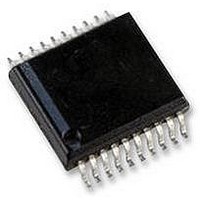USB-FILESYS-SS HEXWAX, USB-FILESYS-SS Datasheet - Page 2

USB-FILESYS-SS
Manufacturer Part Number
USB-FILESYS-SS
Description
DRIVERFREE USB CONFIGURATION, 20SSOP
Manufacturer
HEXWAX
Datasheet
1.USB-FILESYS-DIL.pdf
(10 pages)
Specifications of USB-FILESYS-SS
Usb Type
FAT File System
Usb Version
2.0
No. Of Ports
1
Supply Voltage Range
1.8V To 5.5V
Operating Temperature Range
-40°C To +85°C
Digital Ic Case Style
SSOP
No. Of Pins
20
Package /
RoHS Compliant
Electrical Specifications
Basic Operation
To the host microcontroller (‘host’), USB-FileSys looks
like a file system accessed with SPI commands. To the
PC, it looks like a flash drive.
The use of the MSD USB profile means that no driver
installation is required. It is plug-and-play compatible
with PCs running Windows (ME or later), Mac (OS 9 or
later) or Linux (4.0 or later).
Pin Functions
The pin functions are shown in table 1. Pins marked n.c.
will be configured as inputs and, in order to minimize
power consumption, should not be left floating.
The pin functions are described in detail below.
Vss, Vdd, Vusb
Vss is the power supply ground reference. Vdd should
be connected to a regulated supply, most usually the
USB power when available and a battery when USB
power is not available. Vusb should be connected, via a
470nF capacitor, to Vss. See for example C8 in figure 4.
OSC1, OSC2
OSC1 and OSC2 should be connected to a 12MHz
parallel cut crystal circuit with 22pF capacitors or a
12MHz resonator with 0.25% total tolerance.
Vpp, PGC, PCD
TEAclipper programming pins. Refer to the TEAclipper
Programming section for details. Note that the Vpp pin
may be subject to voltages as high as 13V during
programming. On the 28-pin device, PGC and PGD will
be configured as outputs in normal use and should be
left floating when not being used for programming.
Media Detect
The Media detect input pin should be pulled low with a
33K resistor if 25AA1024 memory used. If the SCK-M
pin is biased low indicating that internal memory is used,
the Media detect pin is ignored.
The Media detect input pin should be high during normal
operation with SD memory. If SD memory removable,
Media detect should be taken low when it is removed. If
the device is connected to a PC, a soft detach and re-
attach will be performed on media removal. The SD
memory must be physically removed so that a power-up
reset is performed when it is re-inserted.
In order to allow USB-FileSys to be programmed in-
circuit, it must be possible to configure the application
circuit so that this input appears to be pulled high via a
22k resistor, or pulled low with a 33k resistor.
p2 of 10
Operating voltage Vdd, 28-pin device
Operating voltage Vdd, 20-pin device
Typical/max supply current, Vdd = 5.0
Typical/max Sleep current, Vdd = 5.0
Operating Temperature
Maximum SPI clock rate
Table 2. Electrical Specifications
26-Aug-10
USB-FileSys / USB-Config
2.7V – 5.5V
1.8V – 5.5V
10mA / 21mA
0.1μA / 2μA
-40°C to +85°C
1MHz
RST#
The 20-pin device has an active low pin in place of the
media detect pin. This should normally be biased high
with a 22k resistor.
D+, D-
USB data I/O. Refer to the USB Connectors section for
details of their connections.
USB Voltage Sense
This input should be high when the device is plugged
into a USB host. Refer to figure 5 for a typical method
of deriving this input from the USB supply input.
USB Activity Indication
Output that can either be used for connecting to an
activity indication LED, or for generating an interrupt
when an USB write event occurs.
If configured as an activity indicator, it is high for
approximately 100ms when USB status is changing, or
a USB command is being processed other than Test
Unit Ready.
operating systems send it approximately once per
second to verify the drive is still available.)
If configured as an interrupt, it can be set to output high
when the PC is executing a write to any sector, or a
write to the root directory entries. The primary purpose
of these functions is to allow the host to capture the date
and time information when the PC closes a file.
PTO#
The “Power Take-Off” output is low when power may be
drawn by the application circuit from the USB supply.
USB-FileSys device is configured to request up to
100mA, allowing the device to operate from unpowered
hubs. It may be reconfigured to request up to 500mA
using the Set Configuration command. If this is done
the device will work from PCs and powered hubs only.
If PTO# is high, the device should draw no more than
100μA. In no event should an external power source
inject power into the USB Vdd line.
Sleep
The Sleep input is be regularly polled. If it is low, the
device and its slave memory enter a low-power sleep
state. When sleep goes high, the device will resume
normal operation within 70ms.
SCK-M, MISO-M, MOSI-M, SSn-M
If SD or 25AA1024 memory is used, these pins are the
SPI serial interface to the memory. 4k7 pull-up resistors
are required on all these lines.
If internal memory is used, SCK-M should be biased low.
SCK-H, MISO-H, MOSI-H, SSn-H
In SPI communications with the embedded host, USB-
FileSys acts as an SPI slave device. USB-FileSys is
selected by transitioning SSn from high to low. At that
time, SCLK should be low (CPOL=0).
edge of SCLK, one bit of data is read on MOSI
(CPHA=0). On the falling edge of SCLK, the data on
HW149-8
(Test Unit Ready is ignored because
www.hexwax.com
On the rising
















